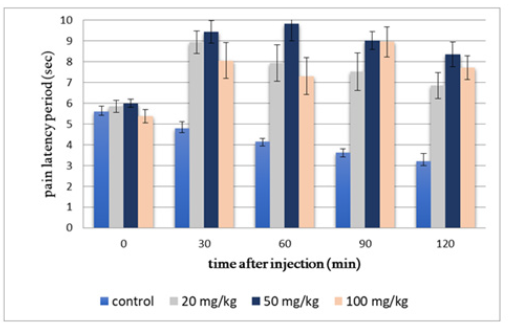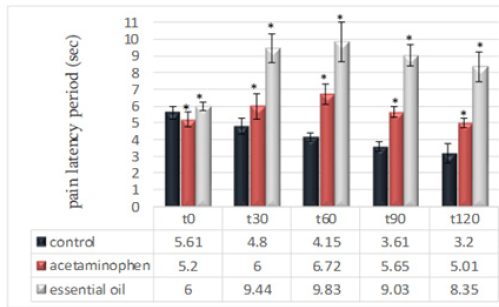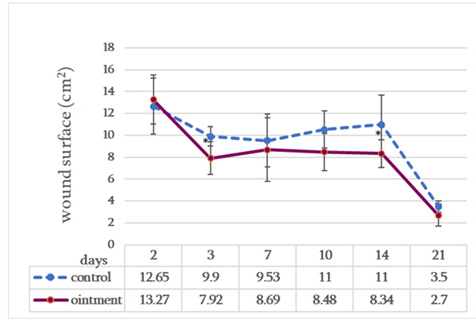- Submissions

Full Text
Novel Research in Sciences
Evaluation Of Pharmacological Activities of Satureja Hortensis Leaves Essential Oil’s Pharmaceutical Forms
Manjikyan AP1, Balasanyan MG2 and Topchyan HV3*
1Department of Pharmacy, Yerevan State Medical University, Armenia
2Department of Pharmacology, Yerevan State Medical University, Armenia
3Department of Drug Technology, Yerevan State Medical University, Armenia
*Corresponding author:Topchyan HV, Department of Drug Technology, Yerevan State Medical University, Yerevan, Armenia
Submission: January 25, 2023;Published: February 08, 2023
.jpg)
Volume13 Issue4February , 2023
Abstract
Satureja hortensis (Summer savory) from Lamiaceae (Labiatae) family is valuable by its rich existence of essential oil. Taking into account several pharmacological effects of mentioned genus essential oil’s compounds, it was investigated the Armenian flora Satureja hortensis essential oil chemical composition, obtained pharmaceutical forms and studied anti-inflammatory, antinociceptive and wound healing activities. Satureja hortensis essential oil chemical composition analysis was carried out by Gas Chromatography-Mass Spectroscopy (GC-MS) method. Antimicrobial effects of the essential oil were studied by disc-diffusion assay. The evaluation indicator for antimicrobial activity was the inhibited zone diameter in the Petri plates. The mentioned oil antinociceptive and anti-inflammatory activities have been estimated correspondingly in the “tail-flick” and xylene induced acute ears edema test of rats’ experimental model. The rats were pretreated with 20, 50 and 100mg/kg doses. The regeneration ability of the ointment from essential oil of Savory leaves under the condition of thermal burn has been studied. The obtained results demonstrate, that Armenian origin Satureja hortensis essential oil contain rich number of monoterpenes and appear expressed anti-inflammatory, antinociceptive, antimicrobial and wound healing activity. The latter is explained by inhibition of some pathogenic microbes’ growth in the wound such as Proteus mirabilis, Klebsiella, Escherichia coli, as well as wound surface decrease during treatment with ointment obtained from Satureja hortensis leaves essential oil. These results indicate that the investigated plant essential oil could be a beneficial source for the development of new agents with the mentioned activity.
Keywords: Satureja hortensis; Essential oil; Anti-inflammatory; Antinociceptive; Antimicrobial activity
Introduction
Plants have a broad range of molecules which can be explored for different medical and biotechnological applications. In spite of a high number of compounds purified from plants and animal secretions, currently only a few pharmaceutical products have been developed from these natural products. New drugs development from the plant raw material, which possess a wide spectrum of pharmacological activities conditioned by their rich secondary metabolites still remains one of the most important problems of the modern medicine [1,2]. This is especially noteworthy for the groups of drugs, which are for the polyvalent pathology diseases healing and their pharmacological effectiveness is accompanied by a number of serious side effects. These groups of drugs are NSAIDs. In this regard compounds study of anti-inflammatory and painkiller medicinal plants origin is too perspective [3,4]. Many plants possess anti-inflammatory and antinociceptive activities due to their active components, such as flavonoids, essential oils, alkaloids [5,6]. Essential oils are natural oils which are typically obtained by distillation and have the characteristic odor of the plant from which they are extracted. Indeed, many natural essential oils have been reported to improve healing in various pre-clinical models of animal wound healing, and some have shown strong antimicrobial effects against the most common pathogenic bacteria present in clinical chronic wound infections [7]. Plants in the family Lamiaceae are a very important source of essential oils. Satureja is a genus of Lamiaceae family and comprises numerous species [8,9]. Presented study aimed to investigate pharmacological activities of Armenian flora Satureja hortensis leaves essential oil.
Materials and Methods
Plant material
The aerial parts of cultivated Satureja hortensis were collected during the flowering period from the Ararat region (Armenia), and were shade dried (25 days) at room temperature with ventilation.
Essential oil extraction and chemical analysis
The essential oil was obtained from dried aerial parts from Satureja hortensis by Ginsburg’s steam distillation method for 2.5 hours, after which it was stored in sealed vials at 4 to 6 °C prior to chemical and pharmacological analysis [3]. Essential oil chemical analysis was verified by GC-MS.
Anti-inflammatory activity
The anti-inflammatory activity of the essential oil was evaluated in albino rats (weighing 150-180g) using xylene-induced ear edema. Edema was induced in each rat by applying xylene (0.03mL) to the anterior and posterior surfaces of the right ear. The rats were pretreated with 20, 50 and 100mg/kg essential oil intraperitoneally, 30min before initiation of inflammation. The control group of animals was untreated. The anti-inflammatory activity was evaluated as decreasing mass differences between right and left ears [10,11].
Results and Discussion
Figure 1: The anti-inflammatory effect of Satureja hortensis leaves essential oil different doses: A-by mass differences, B-by percentages. M±SE, n=10, *p<0.05 compared with control group.

Satureja hortensis leaves essential oil was obtained by 2.9% amount, which represents light yellowish liquid with typical smell. The qualitative analysis of the essential oil revealed that it contained aromatic mono- and diterpenoids. According to our data, obtained by GC-MS method, 13 components were found in the essential oil, the highest amount of which is carvacrol (42.262%) and g-terpinene (32.020%) [14]. According to literature data, they display anti-inflammatory, antinociceptive and antimicrobial activity [6,15,16]. Carried out experiments showed that the essential oil appears dose-dependent anti-inflammatory activity against acute inflammation in the xylene induced ear edema test. Thus, the mass difference between right and left ears in control group was 88.67 (±13.9) mg. After intraperitoneal injection of 20mg/kg of essential oil, mass differences between right and left ears decreases up to 43.93 (±17.7)mg, which prevents edema by 50.45% (p<0.05). Further dose enhancement decreases the antiinflammatory activity: at the 50 and 100mg/kg of essential oil injection mass differences between right and left ears were 55.56 (±13.7) and 68.81 (±17.6) mg respectively, which reduce edema by 37.35% (p<0.05) and 22.41% (p=0.1) respectively compared to the control group (Figure 1). Data shown in the (Figure 2) demonstrate that essential oil emulsion significantly increases the latency period of pain. The mentioned effect has dose-dependent character. Thus, 30 minutes after injection of 20mg/kg essential oil emulsion, tailflick time increased by 52.6%, 35.6% after 60 min, 28.4% after 90 and 16.9% after 120 minutes compared with the same index before the injection. Increasing the dose of essential oil emulsion to 50mg/ kg pain latency time is more pronounced in all recorded periods (30, 60, 90 and 120min) compared to the initial time it is 55.1%, 61.1%, 48.4%, 37.3%, respectively. In the case of 100mg/kg dose it was 49.9%-30min, 35.9%-60min, 66.7%-90min, 43.6%-120min, respectively. Obtained data indicate that the highest antinociceptive activity is expressed in 50mg/kg dose of Satureja essential oil injection.
Figure 2: Antinociceptive effect of Satureja hortensis essential oil different doses in “Tail-flick” test (M±SE, n=10).

Figure 3: Antinociceptive effects of Satureja hortensis essential oil and acetaminophen (M±SE, n=10) *p<0.001 compared with control group.

According to literature data, compounds with predominantly central antinociceptive mechanism of action are tested in the “tail-flick” test [17]. In this regard, acetaminophen (with predominantly central antinociceptive mechanism of action) at the dose of 300mg/kg was compared with Satureja essential oil antinociceptive activity. It can be seen from (Figure 3) that Satureja essential oil antinociceptive effect is comparable and even exceeds the antinociceptive effect of acetaminophen. Based on anti inflammatory and antinociceptive activity of Satureja hortensis essential oil, it was investigated the ability of mentioned oil to regenerate damaged tissue. Carried out experiments show that wound surface decreased on 3rd, 7th, 10th, 14th days after thermal burn by 19%, 9,9%, 23%, 24% consequently compared with control group (Figure 4). To clarify the wound healing mechanism of Satureja essential oil ointment antibacterial study and wound surface pH detection were carried out. It has been found out that noted ointment influences on some pathogenic bacteria, such as Proteus mirabilis, Klebsiella, Escherichia coli (Table 1), in which result pH of burn surface is decreased (Figure 5).
Figure 4: Burn wound surface changes under influence of Satureja hortensis essential oil ointment (M±SE, n=6) *p<0.05 compared with control group.

Table 1:Influence of the ointment obtaind from Satureja hortensis essential oil on wound microflora.

Figure 5: Burn wound surface difference under influence of Satureja hortensis essential oil ointment in the 14th day a) rat from the control group, b) rat from the tested group.

To interpret the results, it should be mentioned that wound surface serves as a good environment for bacterial growth, where a number of enzymes activity is increased, such as protease, urease, etc [18]. These enzymes inhibit wound regeneration processes. It is also known that higher pH values are typical to the wound surface, compared with unaffected skin. The explanation for this lies in the high urease activity of Proteus mirabilis bacteria, which leads to accumulation of ammonia and increases in pH [19]. Since during application of the mentioned ointment is found not only the Proteus mirabilis bacteria growth absence also lowering the average pH-value of the test group compared to the control group, it can be concluded about ointment favorable influence on the wound regeneration process.
Conclusion
These results indicate that Satureja hortensis leaves essential oil could be served as a potential source for development of new agents with analgesic, anti-inflammatory and wound healing activities.
References
- Atanasov AG, Waltenberger B, Pferschy WEM, Linder T, Christoph W, et al. (2015) Discovery and resupply of pharmacologically active plant-derived natural products: A review. Biotechnology Advances 33(8): 1582-1614.
- Alam SH (2009) Antimicrobial activity of natural products from medicinal plants. Gomal Journal of Medical Sciences 7(1): 72-78.
- (2010) WHO, Traditional herbal remedies for primary health care, Switzerland.
- Igbe I, Inarumen GO (2013) The effect of leaf aqueous extract of Brachystegia eurycoma harms (Fabaceae) in acute and chronic inflammatory animal models. British Journal of Pharmaceutical Research 3(3): 391-400.
- Obeidat M, Shatnawi M, Alawi AM, Zubi AE, Dmoor AH, et al. (2012) Antimicrobial activity of crude extracts of some plant leaves. Research Journal of Microbiology 7(1): 59-67.
- Da Silveira e Sá RC, Cardoso Lima T, Da Nóbrega FR, Medeiros de Brito AE, De Sousa DP (2017) Analgesic-like Activity of Essential Oils Constituents. An Update. International Journal of Molecular Sciences 18(12): 2392.
- Kennewell TL, Mashtoub S, Howarth GS, Cowin AJ, Kopecki Z (2019) Antimicrobial and healing-promoting properties of animal and plant oils for the treatment of infected wounds. Wound Practice and Research 27(4): 175-183.
- Dunkic V, Bezic N, Vuko E, Cukrov D (2010) Antiphytoviral activity of Satureja montana ssp. Variegate (Host) P W ball essential oil and phenol compounds on CMV and TMV. Molecules 15(10): 6713-6721.
- Bezic N, Skocibusic M, Dunkic V (2005) Phytochemical composition and antimicrobial activity of Satureja montana and Satureja cuneifolia Ten. Essential oils. Acta Bot Croat 64 (2): 313-322.
- Foong CHP, Hamid RA (2012) Evaluation of anti-inflammatory activities of ethanolic extract of Annona muricata Brazilian Journal of Pharmacognosy 22(6): 1301-1307.
- Ramezani M, Amin GH, Jalili E (2010) Antinociceptive and anti-inflammatory effects of hydroalcohol extract of Vitex agnus castus fruit in mice. World Academy of Science Engineering and Technology 11(4): 46-51.
- Kariuki HN, Kanui TI, Yenesew A, Mbugua PM, Patel NB et al. (2012) Antinociceptive activity of the root extracts of rhus natalensis kraus and Senna singueana. Phytopharmacology 2(2): 312-317.
- Mayrovitz HN, Lisa BS (2009) Wound areas by computerized planimetry of digital images: Accuracy and reliability. Advances in Skin & Wound Care 22(5): 222-229.
- Manjikyan A, Balasanyan M, Topchyan H, Melikyan L, Nikoyan N, et al. (2015) Armenian flora Satureja hortensis essential oil as a source of antimicrobial agents. International Review of Education and Science 1(8): 716-721.
- Mondal M, Quispe C, Chandan S, Tapash CB, Jahir MA, et al. (2021) Analgesic and anti-inflammatory potential of essential oil of Eucalyptus camaldulensis leaf: In Vivo and in silico studies. Natural Product Communications 16(4): 1-16.
- Merajuddin K, Shams T, Khan M, Ahmad AM, Adeem M, et al. (2019) Chemical diversity in leaf and stem essential oils of Origanum vulgare and their effects on microbicidal activities . AMB express 9(1): 176.
- Park SH, Sim YB, Kim SM, Kang YJ, Lee JK, et al. (2011) Antinociceptive profiles and mechanisms of orally administered Aster koraiensis extract in the mouse. Journal of Medicinal Plants Research 5(27): 6267-6272.
- Slonczewski JL, Foster JW (2010) Microbial infection of burn wounds.
- Niinikoski J, Grislis G, Hunt TK (1972) Respiratory gas tensions and collagen in infected wounds. Annals of Surgery 175(4): 588-593.
© 2023 Topchyan HV. This is an open access article distributed under the terms of the Creative Commons Attribution License , which permits unrestricted use, distribution, and build upon your work non-commercially.
 a Creative Commons Attribution 4.0 International License. Based on a work at www.crimsonpublishers.com.
Best viewed in
a Creative Commons Attribution 4.0 International License. Based on a work at www.crimsonpublishers.com.
Best viewed in 







.jpg)






























 Editorial Board Registrations
Editorial Board Registrations Submit your Article
Submit your Article Refer a Friend
Refer a Friend Advertise With Us
Advertise With Us
.jpg)






.jpg)














.bmp)
.jpg)
.png)
.jpg)










.jpg)






.png)

.png)



.png)






